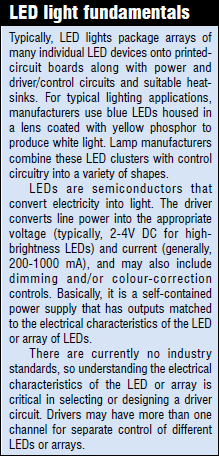Light-emitting diodes (LEDs) produce a radically different type of lighting than what we are used to. Already in use in many architectural and commercial applications,these are now reaching our homes too.For a country like India, which struggles to meet the increasing electricity demand with growth in the economy,the biggest benefit of LED lighting is energy saving.
According to India’s Ministry of Power, the country plans to build 80 new coal-fired power plants to keep up with the rising electricity demand over the next five years. But the potential savings from simply changing light bulbs to the new LED technology can significantly reduce the country’s electricity demand by as much as 40 per cent.
LEDs would significantly reduce the lighting load, peak demand and overall energy consumption without compromising on the environment safety as it has no mercury and heavy metal content.
The opportunity
The Indian market for LED lighting is expected to grow to $400 million by 2015 (at a rate of 53 per cent per annum), making it one of the fastest growing sectors.
According to Electric Lamp & Component Manufacturers’ Association of India (ELCOMA), the entire lighting industry production in India in 2009 was worth about Rs 71.67 billion, of which the share of LED lighting was only Rs 2.16 billion. The market will be driven by such factors as government support for promoting investments in energy-efficient lighting, development of national standards for testing and performance evaluation, transfer and improvements in existing technology for new applications, global mandate to address greenhouse gas (GHG) emissions, and decline in average prices of LED.
The efficacy and life of LED lighting would improve over a period of time. Efficacy is expected to double in the next 20 years. Formation of national standards for LEDs will accelerate the market development.
The nationwide LED Village Campaign by Bureau of Energy Efficiency (BEE) has come as a booster. Under the campaign, LED-based street lights are being installed in villages. LEDs are also being used on a large scale in appliances like air-conditioners and televisions.
Is India ready?
No industry can be driven unless it has the right set of skilled people. In India, since there has not been much focus on lighting education, the industry is in dire need of lighting professionals.
“Most of the Indian lighting industry is still dependent on foreign MNCs for any innovation. One simple reason is that there is no technical institute at the moment which teaches lighting as a subject and its association with electronics. Our electronics hardware manufacturing sector to a large extent doesn’t even know what lighting electronics is,” says Praveen Kumar Sood, chairman, Regnant Group.
“Thankfully, now the government has awakened. We are in touch with the Ministry of Renewable Energy, TERI and Indian Society of Lighting Engineers. We are asking the institutes and universities to start courses in lighting electronics,” he adds.
What goes inside?
“Earlier, lighting used to be the science of physics related with optics. Now it’s more science of electronics. Again, it’s not all electronics. Chips are made of metals, and metals come under metallurgy, with composition and organic structure. Thus it involves the sciences of chemistry, metallurgy, physics and electrical engineering too. Whatever is there, it’s being controlled with the help of electronics. So it’s no more just illumination. Lighting today is a multidisciplinary subject,” explains Dr Prakash Barjatia, former director, MIT School of Energy & Lighting, Pune, and chairman, Mumbai State Centre, Indian Society of Lighting Engineers.
LED per se is not a light source. It’s a semiconductor diode that emits light and the light is controlled by a controller. Without the controller, it can’t work. Then comes the science of physics in heat dissipation. Whatever heat is generated, if it’s not dissipated properly, the module will not perform effectively.
“Very few companies make LEDs in India. On the other hand, LED drivers are designed and manufactured by many companies in India,” informs Dr Barjatia.

Skills required
LED lighting requires knowledge of all the sciences mentioned above. If you look at the basic concept of an LED, there is the role of electronics engineers. But if you consider an overall luminary where LED or some other light source can be used, role of lighting designers and electrical engineers too comes into play. Proper lighting is more a role of creativity as it can do wonders by elevating your mood, for instance.
It also helps to have some knowledge of management. To sell a product in the market, one needs to know how LED is better than other lighting technologies. LED is energy-efficient but there are other such sources as well.










